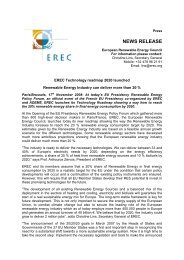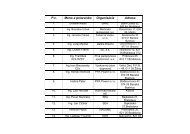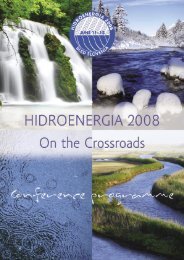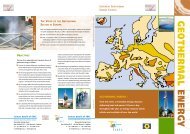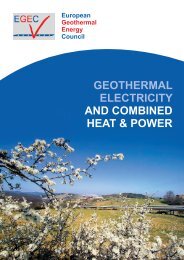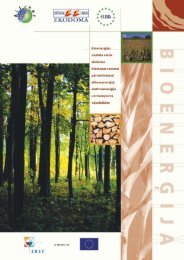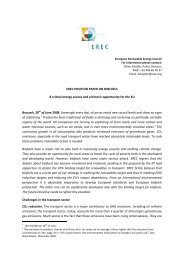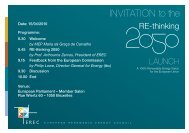CTO Assessment - European Commission
CTO Assessment - European Commission
CTO Assessment - European Commission
You also want an ePaper? Increase the reach of your titles
YUMPU automatically turns print PDFs into web optimized ePapers that Google loves.
PAUL LOEBE HAUS<br />
Sustainable Energy<br />
Public Building<br />
Contact: Johannes Hanf • Braunfels Architekten<br />
D-10969 Berlin • Germany • Tel: +49 30 2537 600<br />
Email: j.hanf@braunfels-architekten.de<br />
One of the major buildings erected in the<br />
governmental quarter of Berlin during the<br />
last years was the Paul Löbe Haus that<br />
houses offices of the federal elected officials<br />
as well as the meeting halls of the Federal<br />
Lower House of Parliament Committee.<br />
The Paul Löbe Haus is a subtle mixture<br />
of PV integration and combined heat and<br />
power plants, accompanied by the target to<br />
reach the energy standard of at least 25%<br />
better than the actual building regulations.<br />
This PV system is the world’s largest thinlayer<br />
system integrated into a building made<br />
of amorphous silicon, the world largest system<br />
made of semi-transparent PV modules,<br />
and one of the largest directed shadow photovoltaic<br />
systems in existence.<br />
Main motivations<br />
During the 1990’s, Berlin has taken the<br />
opportunity of the move of the headquarters<br />
of the German capital from Bonn to<br />
Berlin to adopt a program of implementation<br />
of RE technologies into the various<br />
public buildings that needed to be erected in<br />
the new governmental quarter in Berlin. The<br />
environmental energy strategy «Solar supplied<br />
governmental quarter» targeted at the<br />
integration of circa 1 MWp of photovoltaic<br />
systems into the governmental buildings. As<br />
well, plans were to provide low energy buildings,<br />
to avoid air-conditioning systems and<br />
to use combined heat and power plants on<br />
the basis of biofuels (rape-oil) for energy<br />
supply.<br />
The Project<br />
The «Paul-Löbe Haus» is a building of about<br />
950 offices for members of the Parliament,<br />
21 conference halls for Parliamentary Committees<br />
and meeting rooms, a seminar area,<br />
two restaurants, the Europe conference hall<br />
and a visitors area. A 123 kWp solar plant<br />
is integrated in the lamella shading system<br />
for the central atrium.<br />
A decentralised renewable energy system<br />
has been built up between the governmental<br />
buildings in the Spreebogen, the governmental<br />
quarter. The buildings are interconnected<br />
with a local electricity grid, as well as with<br />
two central seasonal aquifer-storages, one<br />
for cooling and one for heat situated below<br />
the Reichstag building. Combined heat and<br />
power plants (CHP –units) are also a major<br />
power supply of this local energy system.<br />
As a result 80% of the consumed thermal<br />
and electric energy of all governmental<br />
buildings in the area are provided with RE.<br />
Overall Evaluation<br />
The integration of a photovoltaic system<br />
however arrived in a later stage of the several<br />
years project implementation to replace<br />
the originally planned aluminium blinds as<br />
a heating system concept. The positioning<br />
of the PV panels was not optimal in terms<br />
of electricity production, but the PV-system<br />
offered other energy benefits, such as the<br />
possibility to use daylight from the north,<br />
without blurring effects, and reducing overheating<br />
in the building.<br />
Hence, despite the fact that certain climatic/<br />
sun conditions cause a contradiction between<br />
optimising the lamella shading system<br />
for daylighting and maximal solar energy<br />
gain of the PV-system, the solution was<br />
to run the system energy optimised in terms<br />
of the overall energy consumption.<br />
Solar<br />
governmental<br />
programme<br />
PV in the Paul<br />
Löbe Haus<br />
Combined heat<br />
and power plants<br />
Energy standard<br />
in the<br />
Paul Löbe Haus<br />
Main innovative aspects<br />
The main innovative aspects are technical,<br />
and certainly demonstrated the importance<br />
of considering the multi-functionality of PV<br />
systems. For instance, in the wintertime,<br />
especially in the afternoon, it is more energy<br />
efficient to use all sunlight for<br />
daylighting, than using it for producing solar<br />
electricity, in which case lamellas can be<br />
moved to minimise shading of the hall.<br />
Challenges<br />
Berlin took the opportunity to become the<br />
demonstration ground for ambitious architectural<br />
projects over the last decade: the<br />
Spreebogen is a symbolic historical area,<br />
containing the Reichstag, and close to the<br />
path of the Berlin wall, thus making it a<br />
powerful centre for innovative architectural<br />
projects. On the other hand, the very large<br />
ground available imposed very little restriction<br />
on architectural design. The only challenges<br />
were therefore how to organise the<br />
most optimal energy system among the different<br />
new buildings.<br />
Replication Potential<br />
It is certainly an impressive achievement in<br />
the field of architecture. The Paul Löbe<br />
House demonstrated how a building based<br />
on renewable energy can be combined with<br />
aesthetic criteria and passive solar techniques.<br />
Environmental strategy «Solar supplied governmental<br />
quarter» with the objective to have circa 1 MWp of<br />
photovoltaic systems into the governmental buildings<br />
123 kWp solar plant, 6,048 semitransparent PV lamellas<br />
were installed on the 5,500 m 2 roof made of saw-tooth glass<br />
World’s largest thin-layer system integrated into a building<br />
made of amorphous silicon<br />
Multi-functionality of PV systems: electricity, but also for<br />
passive solar house purposes<br />
Biofuels (rape-oil) energy supply; 80% of the consumed<br />
thermal and electric energy of all govermental buildings in<br />
the area are provided with RE<br />
At least 25% better than the actual building regulations<br />
80% of the consumed thermal and electric energy of all<br />
govermental buildings in the area are provided by RE<br />
52 <strong>CTO</strong> - Showcase



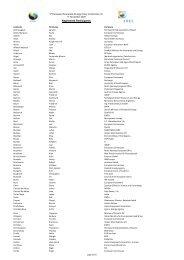
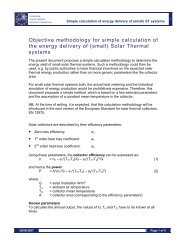
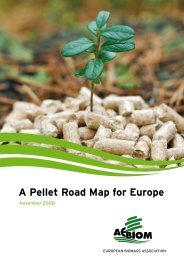
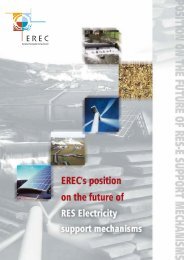

![Energy [R]evolution - Greenpeace](https://img.yumpu.com/47174859/1/184x260/energy-revolution-greenpeace.jpg?quality=85)
